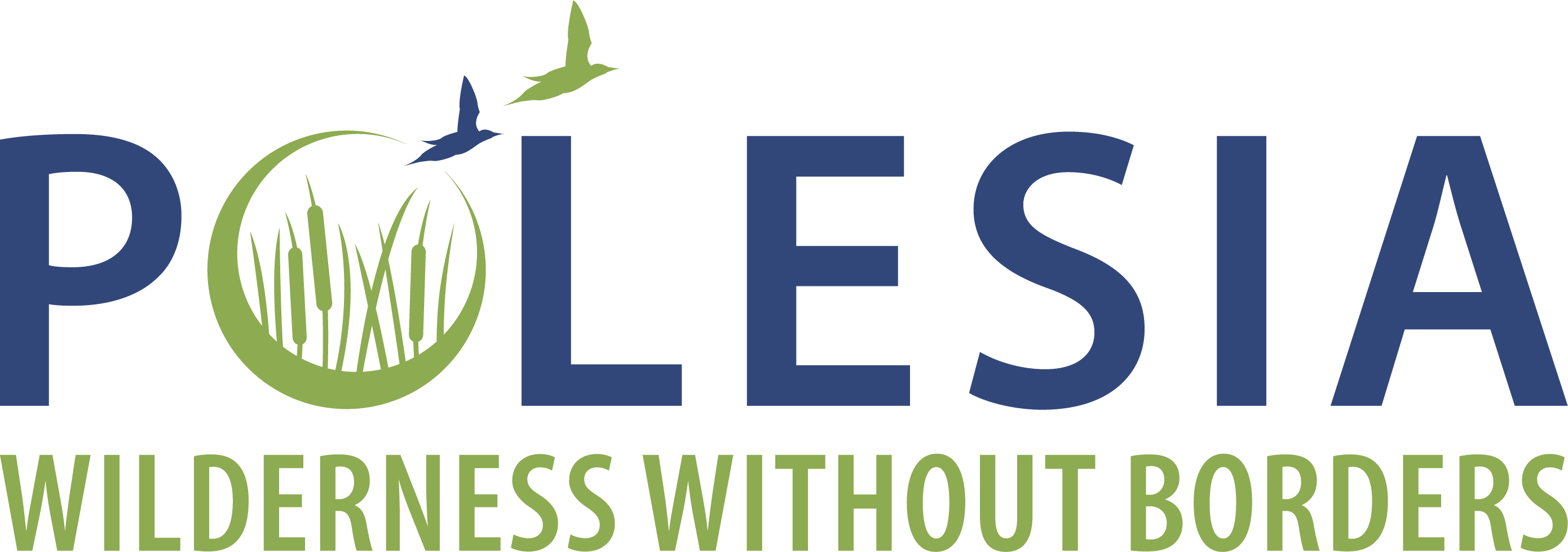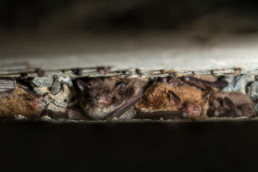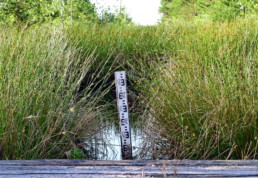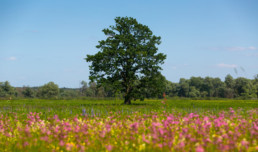Chornobyl on fire: the growing problem of wildfires in the exclusion zone
Landscape fires are a natural process in ecosystems. But a combination of anthropogenic and climatic factors can turn them into an acute problem. Experts predict that temperate regions are likely to be at risk of increasing frequency of large and devastating fires due to climate change. The Chornobyl Exclusion Zone (CEZ) is one of the areas where the problem of landscape fires is already acute, exacerbated by the heavy contamination of the area. Therefore, fighting and - even more importantly - preventing wildfires are among the priority tasks in the management of this extremely significant territory.
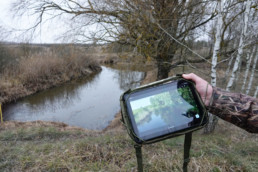
The Chornobyl Exclusion Zone that emerged after the accident at the nuclear power plant in 1986 is shared between Ukraine and Belarus being a part of Polesia. It is considered one of the most heavily contaminated by radionuclides areas in the world. In both countries the Exclusion Zone is protected, controlled and studied. In 1988, the Polesie State Radioecological Reserve was founded in the Belarusian part of the CEZ. In 2016, the Chornobyl Radiation and Ecological Biosphere Reserve was established in Ukraine. Scientists and conservationists carry out research and monitoring of the radiation contamination, landscape dynamics and wildlife in the area of the Exclusion Zone.
The main consequence of the Chornobyl accident is the severe radioactive contamination of a large area. It’s extremely important to take measures to prevent the spread of radioactive substances that have accumulated in the environment. Since the collapse of the Soviet Union, Belarus and Ukraine have taken such measures independently and in different ways.
In 1992-1993, many of the drainage channels in the Belarusian part of the exclusion zone were blocked. This measure was planned to reduce the spread of radioactive sediment from the Pripyat River basin downstream, but a significant portion of the soluble strontium had already been carried to the Pripyat River in the years after the accident. Over time, this also led to increased water retention in the canals, contributing to the rewetting of certain areas and the recovery of wetland ecosystems.
In the Ukrainian part of the CEZ, canals in the most contaminated areas were also blocked in 1986 and the following years, as part of a comprehensive plan to protect water resources from radiation contamination. At the same time, a strategy was chosen to maintain minimal flooding of the catchment area to reduce the water migration of strontium-90 and other radionuclides. These almost opposite tasks required such a scenario for managing the former drainage systems to retain water during periods of high risk of landscape fires, but to prevent prolonged flooding of the territory.
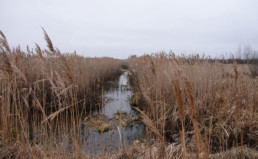
Experts note that the total length of drainage canals in the Ukrainian part of the Chornobyl Zone is four times greater than the length of the small rivers of this territory. Since the accident, the drainage infrastructure has gradually deteriorated and the canals are now overgrown with bushes and grass. Some natural restoration of the wetlands is taking place. However, the scale of these positive processes is insignificant and the drainage systems continue to have a draining effect on the surrounding area.
Another factor exacerbating the problem of fires in the Chornobyl Zone is climate change. Periods of hot, dry weather have become more frequent and longer in recent years. Instead of prolonged rainfall, there are more short-term rains that evaporate quickly, leaving little time for rivers and aquifers to recharge. Winters with little or no snow are becoming increasingly common in Polesia. This means that the soil remains unsaturated with moisture until spring. If we speak about peat soils typical for region, the risk of large fires is very high here: dry peat burns easily, is difficult to extinguish and retains the smoldering nests for a very long time, which can be activated under favorable conditions.
Human factor: the cost of one thoughtless act
According to the research conducted as part of our project, two of he ten largest landscape fires in Polesia between 2001 and 2019 occurred in the Chornobyl Exclusion Zone – one in the Belarusian part and one in the Ukrainian part. Fire statistics in the two countries can be unreliable, but overall the number of fires occurring on the Ukrainian side is several times higher than on the Belarusian side. Specialists insist that the human factor plays a key role here.
The human presence in the Ukrainian part of the CEZ is quite significant. Economic activity is limited here, except for the rather intensive activity of maintaining the nuclear power plant and radioactive waste storage facilities, as well as related infrastructure (roads, power lines, forestry, etc.). Before the Russian military invasion, tourism was highly developed here. Some people enter the zone illegally, there are squatters who return to their homes abandoned in the course of evacuation. The activities of local people whose farms border the reserve also play a role. They still burn dry vegetation in spring and after harvest – the times when most forest fires start on agricultural land and then spread uncontrollably to natural areas.
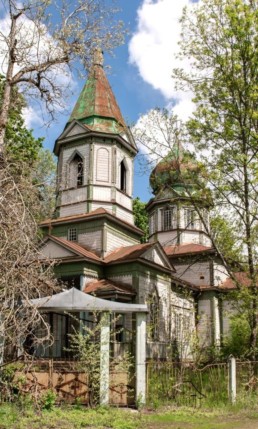
In recent years, there have been worrying reports of fires in the contaminated areas. A case in point is what happened in the spring of 2020. In early April, a fire broke out in the area adjacent to the Chornobyl Exclusion Zone and began to spread through the protected area. Investigations later revealed that it was most likely caused by the careless actions of a local resident. In dry and windy conditions, the fire spread rapidly. Embers formed in the dry peat bogs and ignited again when the wind picked up. The fire approached the nuclear power plant and the nuclear waste facilities. The flames also reached the so-called “Red Forest” – the woodland area around the plant which was exposed to the highest radiation doses during the 1986 accident and is still one of the most contaminated parts of the Chornobyl Zone. The total area affected by the fires reached more than 67,000 hectares. Hundreds of firefighters and a wide range of equipment, including aircraft, were used to extinguish the flames, but it took more than a month to bring the fires under control. Situation deteriorated after the Russian military invasion. In addition to natural conditions and human activities, unexploded ordnance contamination and a lack of firefighting equipment exacerbated the problem, reducing firefighting capacity and slowing fire suppression. In recent years big wildfires can be expected due to warfare consequences.
Radiation spreading: invisible danger
In the case of fires in the Chornobyl Zone, there are many concerns about the possible spread of radioactive substances by air currents along with the products of combustion. Specialists claim that the burning of the ground cover itself does not lead to a dangerous increase in background radiation. However, it increases radionuclide concentration in air and leads to migration with smoke.
Scientists at the Norwegian Institute for Air Research have studied the effects of forest fires on the atmosphere in the Chornobyl Zone in Ukraine and Belarus. They point out that the increasing amount of dead trees and litter can provide fuel for wildafires, which pose a high risk of radioactivity redistribution in future years. According to their modeling, intense fires in 2002, 2008 and 2010 caused caesium-137 to move southwards; the cumulative amount of caesium-137 redeposited over Europe could be 8% of the amount deposited after the Chornobyl disaster in 1986. A large amount of dangerous, long-lived and refractory radionuclides are still present in the Chornobyl Exclusion Zone. Scientists predict a high risk of radionuclide redistribution in the future due to the expansion of the burnable area associated with climate change.
A field study conducted jointly by Ukrainian and Japanese scientists has found that the rate of radionuclide leaching and weathering after fires temporary increases by a factor of 30 compared to the rate before the fire.
Fires and wildlife
The Chornobyl Zone is often cited as a benchmark example of unguided rewilding. With very little human influence in recent decades, wildlife has regained its territory. The proportion of forests and mires has increased significantly, and populations of many wild animals, including ungulates, predators such as lynx and wolf, as well as rare birds, have grown. Where intensive agriculture was once practiced, plants listed in the Red Book now grow. But this progress can easily be undone by flames. Large fires cause great damage to natural values. They destroy forests, which regrow slowly. Small and sedentary animals die because they cannot escape quickly from the oncoming fire and smoke. Large animals may escape, but when they return they find their habitat is no longer suitable. Spring fires, which coincide with the nesting season of birds, disrupt their breeding cycles.
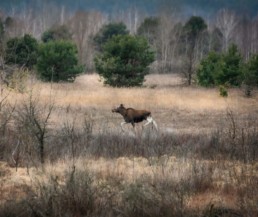
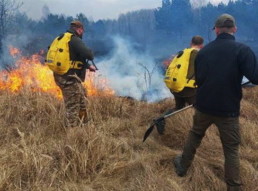
Experience in recent years has shown that during long periods of drought, with strong winds and a lack of moisture in the natural environment, forest fires become difficult to control. Fighting the fires and dealing with the aftermath requires significant resources and financial investment, and the negative consequences are multifaceted and severe. Obviously, it is important to build the capacity of fire–fighting services and to combat the irrational and dangerous behavior of local residents through both educational and administrative measures. In the long term, however, the most effective way may be to restore the water regime in areas where there is a problem of water scarcity. Let us not forget that many scientists predict that this problem will only get worse in the context of climate change.
One of the current priorities of our cooperation with the Chornobyl Radiation and Ecological Biosphere Reserve (Ukraine) is the rewetting of previously drained areas. Large-scale restoration of wetland ecosystems in this area is currently impossible. However, our role is to work with the reserve’s specialists from site selection through to practical implementation, so that they gain the experience and knowledge necessary to continue this vital work in the future.
Safe and intact: protecting rare and typical habitats in Polesia
19. September 2025
0 Comments7 Minutes
The project “Polesia – Wilderness Without Borders” is part of the Endangered Landscapes & Seascapes Programme and is funded by Arcadia. The project is coordinated by Frankfurt Zoological Society (FZS).
